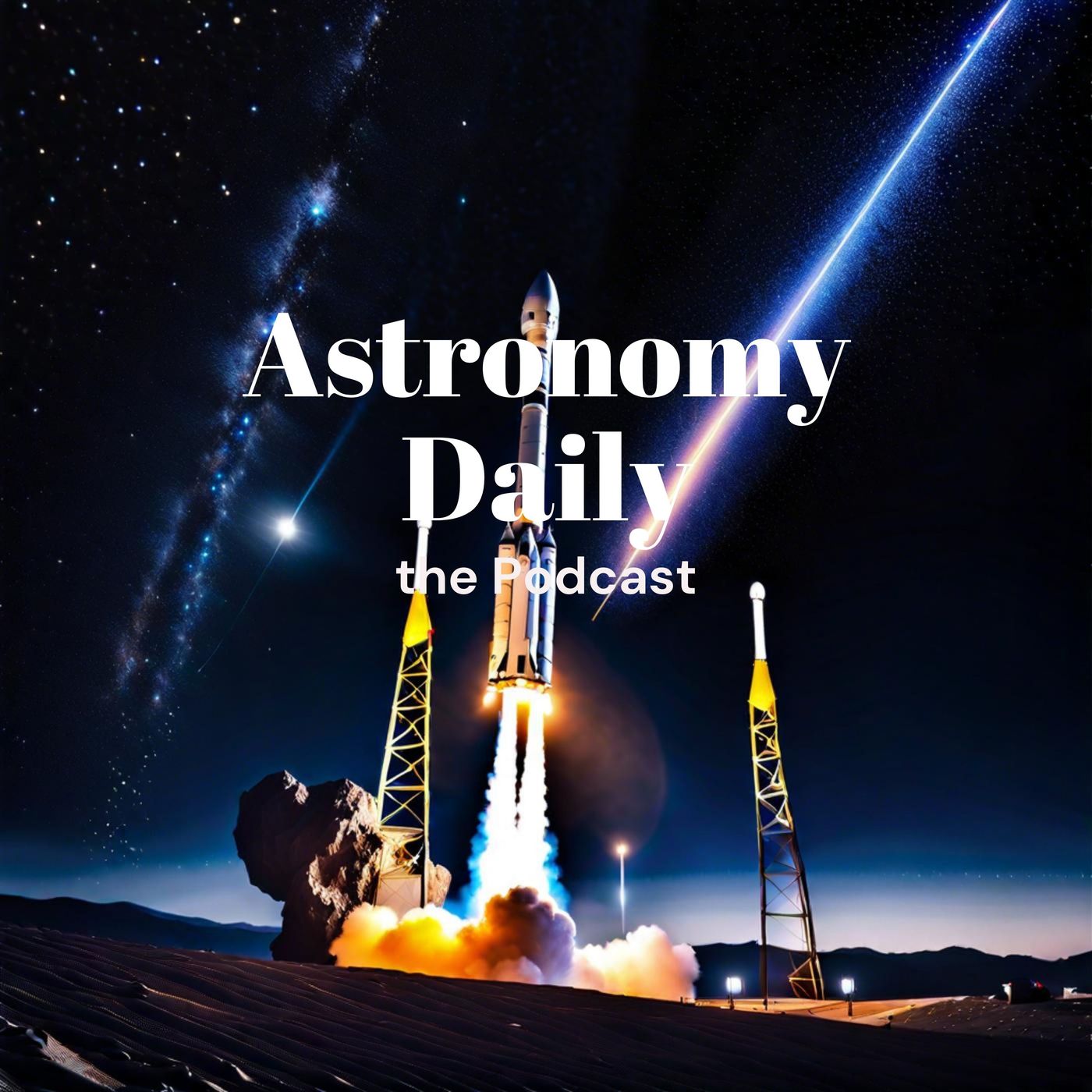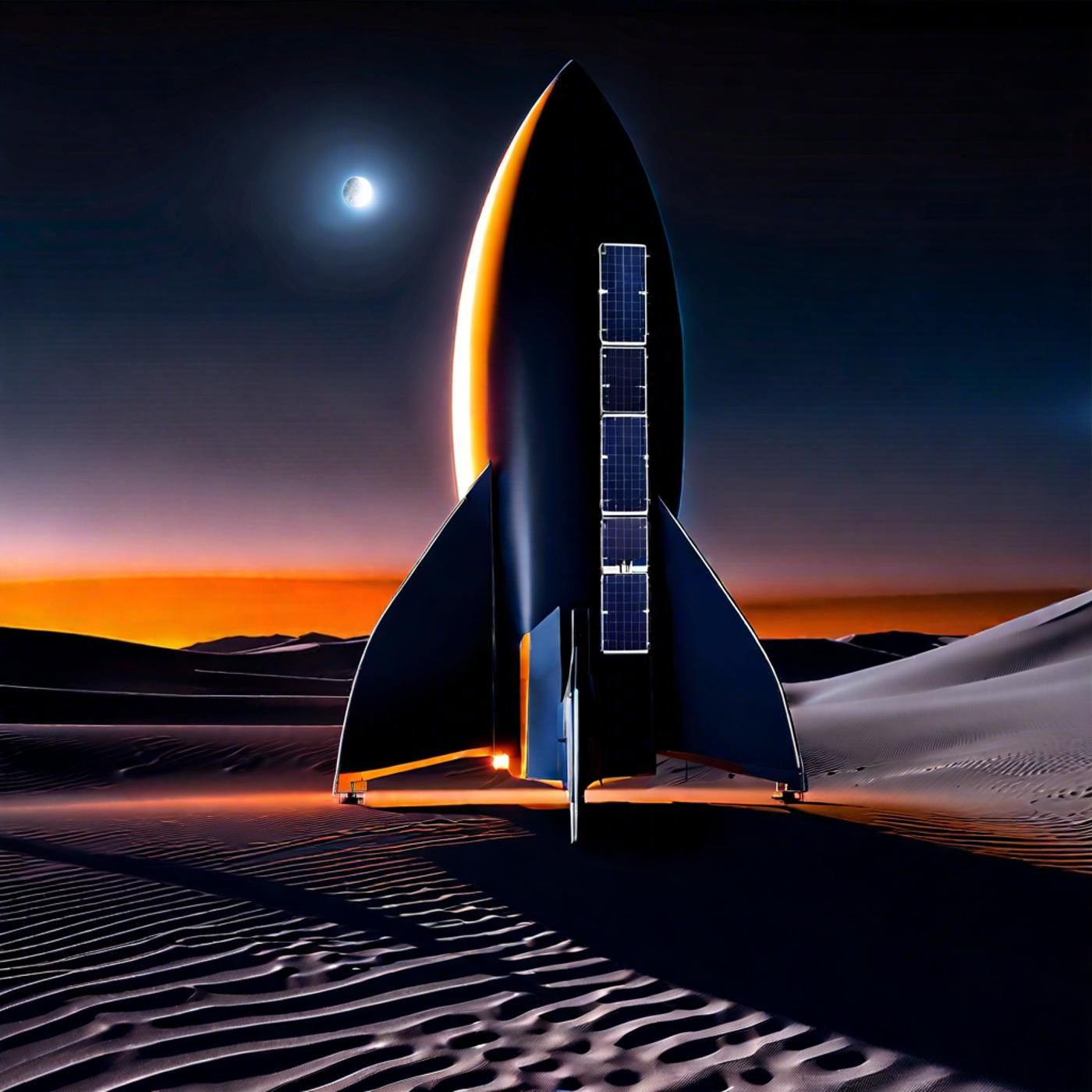S03E99: Virgin Galactic's New Facility & SpaceX's Starlink Anomaly
Welcome to another episode of Astronomy Daily. I'm your host, Anna, and I'm thrilled to bring you the latest updates from the cosmos. Today we have an exciting lineup of stories that span from cutting-edge manufacturing breakthroughs to game-changing...
Welcome to another episode of Astronomy Daily. I'm your host, Anna, and I'm thrilled to bring you the latest updates from the cosmos. Today we have an exciting lineup of stories that span from cutting-edge manufacturing breakthroughs to game-changing proposals in planetary science. So get comfortable, and let's embark on this journey through the latest frontiers of space and astronomy.
Episode Highlights
- Virgin Galactic's New Manufacturing Facility: Virgin Galactic has achieved a significant milestone with the completion of their new state-of-the-art spaceship manufacturing facility in Phoenix, Arizona. This facility is set to revolutionize the final assembly of their next-generation Delta spaceships, aiming for commercial operations by 2026.
- - ispace Rocket Setback: The Chinese private aerospace firm ispace faced a significant setback during the test flight of their SQX-1Y8 rocket. We'll discuss the mission, what went wrong, and the ongoing investigation to determine the cause of the failure.
- - Redefining Planets: A group of planetary scientists led by UCLA professor Jean-Luc Margot has proposed a new definition of what constitutes a planet. This new proposal aims to include exoplanets and provide a more precise classification system.
- - SpaceX Falcon 9 Starlink Launch Anomaly: SpaceX encountered a rare issue with their Falcon 9 rocket during the launch of Starlink satellites. We'll examine the implications for future missions and what this means for the Starlink satellite constellation.
- If you enjoyed today's episode, be sure to visit our website at astronomydaily.io, where you can catch up on all our episodes and stay updated with the latest in space and astronomy news. We love having you as part of our astronomical community, so keep tuning in for more stellar content. Until next time, clear skies and happy stargazing.
- For an extra special deal from our sponsor, Malwarebytes - cyber security for everyone, visit www.bitesz.com/malwarebytes ....but be quick. For a very limited time you get 50% off. You really don't want to miss this. It's one we use and swear by. It just works!
Become a supporter of this podcast: https://www.spreaker.com/podcast/astronomy-daily-the-podcast--5648921/support.
Today's featured stories span from cutting edge manufacturing to planetary science proposals
Anna: welcome to another episode of Astronomy Daily. I'm your host, Anna, and I'm thrilled to bring you the latest updates from the cosmos. Today we have an exciting lineup of stories that span from cutting edge manufacturing breakthroughs to game changing proposals in planetary science. First, we'll be diving into Virgin Galactic's newest development, a state of the art spaceship manufacturing facility in Phoenix, Arizona, designed to revolutionize the final assembly of their next generation delta spaceships. Next up, we'll cover a recent setback experienced by the chinese private aerospace firm ispace during their test flight of the SqX one y eight rocket. We'll discuss the mission, what went wrong, and the ongoing investigation. Then we'll shift gears and explore an intriguing new proposal from planetary scientists that aims to redefine what we consider a planet extending the criteria beyond our solar system. Finally, we'll take a look at SpaceX's Falcon nine starlink launch anomaly that occurred recently, examining the implications for future missions and what this means for the Starlink satellite constellation. So get comfortable, and let's embark on this journey through the latest frontiers of space and Astronomy. Dive in with me as we explore these fascinating stories right here on Astronomy Daily.
Virgin Galactic announces completion of their new manufacturing facility in Phoenix, Arizona
Virgin Galactic has achieved a significant milestone, announcing the completion of their new manufacturing facility in Phoenix, Arizona. This cutting edge facility is dedicated to the final assembly of Virgin Galactic's next generation Delta spaceships, and it's set to revolutionize the company's future space endeavors. The facility, now fully operational, is a bustling hub of activity where Virgin Galactic's technical operations and manufacturing personnel are gearing up for what's next. Starting in Q 420 24, tooling installation will begin, paving the way for production to kick off in Q 120 25. This is where the magic happens. As major sub assemblies think. Wings, fuselages, and the intricate feathering system will come together to form the first two ships of the Delta fleet. Once ground testing wraps up in Phoenix, these completed spaceships will be transported by Virgin Galactic's mothership to Spaceport America in New Mexico, where they'll undergo rigorous flight testing. If all goes according to plan, we can expect commercial operations to take flight by 2026. What's particularly impressive about this multi use facility is its dual hangars equipped with multiple bays, offering immense flexibility for building and testing space vehicles. Virgin Galactic is leveraging advanced digital twin technology to enhance these operations. This technology enables m real time collaboration between the company and its suppliers, ensuring strong governance, efficiency, and reliability. Virgin Galactic CEO Michael Colglazier emphasized the significance of this development. The completion of our new manufacturing facility is an important milestone in the development of our fleet of next generation spaceships, the key to our scale and profitability, he remarked. The arrival of tooling in the coming months is pivotal, setting the stage for spaceship final assembly to begin as planned. Looking back in May 2024, Virgin Galactic inaugurated a ground testing facility in southern California specifically designed for delta subsystem testing, this facility focuses on crucial aspects like avionics, feather actuation, pneumatics and hydraulics. Using an iron bird test rig to simulate real world conditions, the new Delta spaceships are set to accommodate up to six private passengers aiming to fly up to eight missions per month. This ambitious goal is part of Virgin Galactic's vision to significantly increase access to space, making it more achievable for those dreaming of a journey beyond Earth. With its state of the art features and robust technological infrastructure, Virgin Galactic's new facility in Phoenix is not just a testament to innovation, but a beacon of the future of commercial space travel. Stay tuned as we watch this thrilling journey unfold, bringing us ever closer to the stars.
A test flight of a commercial carrier rocket from I-Space has failed
M the recent test flight of the SQX one Y eight, a commercial carrier rocket from the chinese private aerospace firm I space, faced a significant setback. The rocket, also known as Hyperbola one, launched from the Zhuquan Satellite Launch center in northwest China at 07:40 a.m. beijing time. Unfortunately, shortly after liftoff, the rocket exhibited abnormal performance, leading to an unsuccessful mission. The SQX one Y eight, standing approximately 20 meters tall, is designed for the commercial satellite market and capable of delivering payloads up to 260 low earth orbit. This setback comes as a significant blow to Beijing Interstellar glory. Space Technology Limited, the official name of ispace, which is one of China's leading private space companies, focusing on commercial rocket development and launches. Currently, an investigation is underway to determine the cause of the failure. The team at ispace is conducting a detailed analysis to gain insights into the issues encountered during the flight. Understanding the root cause is crucial for the company to address these challenges and improve the reliability of their future missions. It's not uncommon for new advancements in space technology to face hurdles. Each setback provides valuable lessons that drive innovation and improvement, bringing us closer to the realization of commercial spaceflight goals the continued efforts of private firms like ispace highlight the increasing role that non government entities play in expanding our reach into space. As investigations proceed, the aerospace community will be eagerly awaiting the findings of hoping for swift resolutions and successful future launches.
A new proposal could redefine what we call a planet
In other news, there's an exciting proposal that's been put forward by a group of planetary scientists that could redefine what we call a planet. Traditionally, as per the International Astronomical Union's 2006 definition, a celestial body must orbit our sun to be classified as a planet. This has led to many debates, as it excludes thousands of exoplanets orbiting other stars that have been discovered in recent years. Jean Luc Margot, a UH UCLA professor of Earth planetary space sciences and physics, alongside his colleagues, is leading a charge to modernize this definition. Their innovative proposal, slated to be presented at the IAU General assembly in August 2024, aims to create a more inclusive and precise classification system. The current definition describes a planet simply it must orbit the sun, be massive enough for gravity to mold it into a spherical shape, and have cleared its orbit of other objects. While straightforward, this definition is limited in scope. It fails to consider the many celestial bodies that orbit stars beyond our solar system, rendering our understanding somewhat archaic. In the context of modern astrophysical discoveries, Margot and his team argue that a more universal definition is necessary. Their proposed criteria include requiring a planet to orbit any star, stellar remnant, or brown dwarf, not just our sun. This shift acknowledges the reality of exoplanets, planets that orbit stars other than the sun, which are now known to be myriad across the galaxy. Additionally, they've suggested quantifiable limits for a planet's mass. According to their research, a body needs to be more massive than ten circumflex 23 kg, but less massive than 13 Jupiter masses, beyond which point thermonuclear fusion occurs, transforming it into a brown dwarf. This mass range is significant because it helps distinguish planets from other types of celestial bodies. More clearly, one of the most contentious parts of the existing definition is the requirement for a planet to have cleared its orbit. This concept is interpreted to mean that a planet is gravitationally dominant enough to either absorb or fling away smaller objects in its path. Margot and his co authors propose refining this by using dynamical dominance, a concept that more precisely describes how a planet interacts with its neighboring space. In their proposal, they also address problems with the current requirement for a planet to be spherical. Observationally, it's tough to confirm the shape of a distant object. Instead, they propose focusing on mass, since bodies meeting the lower mass limit of ten circumflex 23 kg are generally spherical due to their gravity. This new definition aims to create a more practical and scientifically accurate understanding of planets. By anchoring the criteria to the most measurable quantity mass, Margot and his colleagues hope to eliminate much of the ambiguity that currently exists. They believe their definition, developed using rigorous mathematical algorithms, will serve as a robust framework for categorizing celestial bodies both within our solar system and beyond. Though an official change by the IAU might be years away, this proposal is a crucial step towards an updated, comprehensive definition that keeps pace with our expanding knowledge of the universe. It underscores the, um, importance of evolving scientific definitions to align with new discoveries and understandings.
SpaceX experienced an anomaly during the launch of their Starlink Internet satellites
Let's dive into the recent anomaly experienced by SpaceX during the launch of their Starlink Internet satellites on Thursday night, July 11, SpaceX encountered a rare issue with its reliable workhorse, the Falcon Nine rocket. The launch took place from Vandenberg Space Force base in California and initially seemed to proceed without a hitch. The rocket's two stages separated right on time, and the first stage successfully landed on a drone ship about eight minutes after liftoff. As planned, however, the anomaly occurred with the rocket's upper stage, which was tasked with deploying 20 Starlink spacecraft to low Earth orbit. According to Elon Musk, SpaceX's founder and CEO, the problem arose during the upper stage's restart to raise the perigee, a maneuver meant to adjust the orbit of the satellites. Musk took to social media, stating that the upper stage experienced what they call a rapid, unscheduled disassembly, or Rud, a term that the company uses to describe an explosion or a disintegration. This rud prevented the second stage engine from completing its second burnt, a critical step for deploying the satellites into their intended orbit. While the satellites were deployed, the perigee, the point in their orbit closest to Earth, may be too low for them to stabilize on their own. An hour after Musk's initial post, SpaceX released more information elaborating that the upper stage engine's failure led to the satellites being placed in a lower than intended orbit. As of now, SpaceX has made contact with five of the deployed satellites. Efforts are underway to use their onboard ion thrusters to raise their orbits to the desired altitude. Interestingly, during the launch, webcast observers noted an unusual buildup of fluffy white material near the second stage Merlin engine while it fired in space. This sighting has led to speculation about a potential propellant leak, though SpaceX has yet to come confirm or deny this theory, the Falcon Nine rocket has an outstanding track record, with 69 launches already accomplished in 2024 alone. Known for its reliability, the Falcon Nine has suffered only one full in flight failure since its debut, which took place during a 2015 mission to launch a dragon cargo capsule to the International Space Station. This incident underscores the unpredictability and challenges inherent in space travel. Even for seasoned players like SpaceX, the Falcon Nine is human rated and has successfully conducted 13 crewed missions, nine of which were to the ISS for NASA. Consequently, the root cause of this anomaly will need to be thoroughly analyzed and addressed to ensure future missions, both crewed and uncrewed, maintain the high standards of safety and reliability SpaceX is known for. Despite this hiccup, SpaceX continues to push the boundaries of what's possible in space technology. The 20 Starlink satellites launched are part of an ambitious plan to expand global Internet coverage, with 13 of these new satellites designed to beam service directly to cell phones. The Starlink mega constellation already boasts more than 6100 operational satellites, with 49 of this year's 69 Falcon nine launches dedicated solely to Starlink missions. It's a reminder of the risks and the dynamic nature of space exploration. As, uh, SpaceX continues to investigate this latest anomaly, the focus remains on learning from each mission success or failure to improve future launches and ultimately make space more accessible for everyone.
Today's episode explores the challenges and complexity of space missions
That brings us to the end of today's episode. What a fascinating journey it has been. We began by delving into Virgin Galactic's ambitious new manufacturing facility in Phoenix, Arizona, designed to revolutionize their delta spaceship production. Then we shifted focus to the setback faced by ispace with their sqx one y eight rocket. Underscoring the challenges and complexity of space missions. We also explored an exciting proposal aiming to redefine what constitutes a planet, a ah, topic that could reshape our understanding of celestial bodies beyond our solar system. And finally, we examined the recent anomaly during SpaceX's Falcon nine launch of Starlink satellites, highlighting the intricacies and unpredictability of space travel. If you enjoyed today's episode, be sure to visit our website at astronomydaily.io where you can catch up on all our episodes and stay updated with the latest in space and Astronomy news. We love having you as part of our astronomical community, so keep tuning in for more stellar content. Until next time, clear skies and happy stargazing.
New to Astronomy Daily - The Podcast?
Here are some great episodes to start with.


















